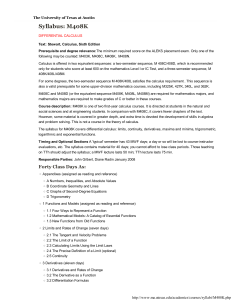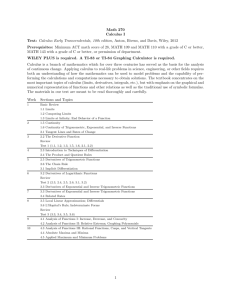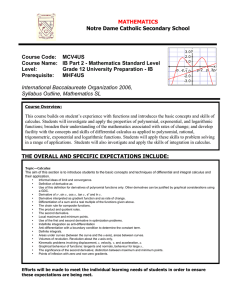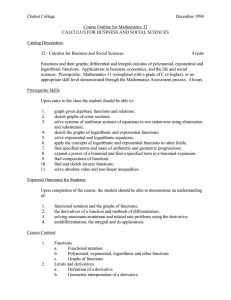Mathematics 161 Calculus for the Life Sciences...
advertisement
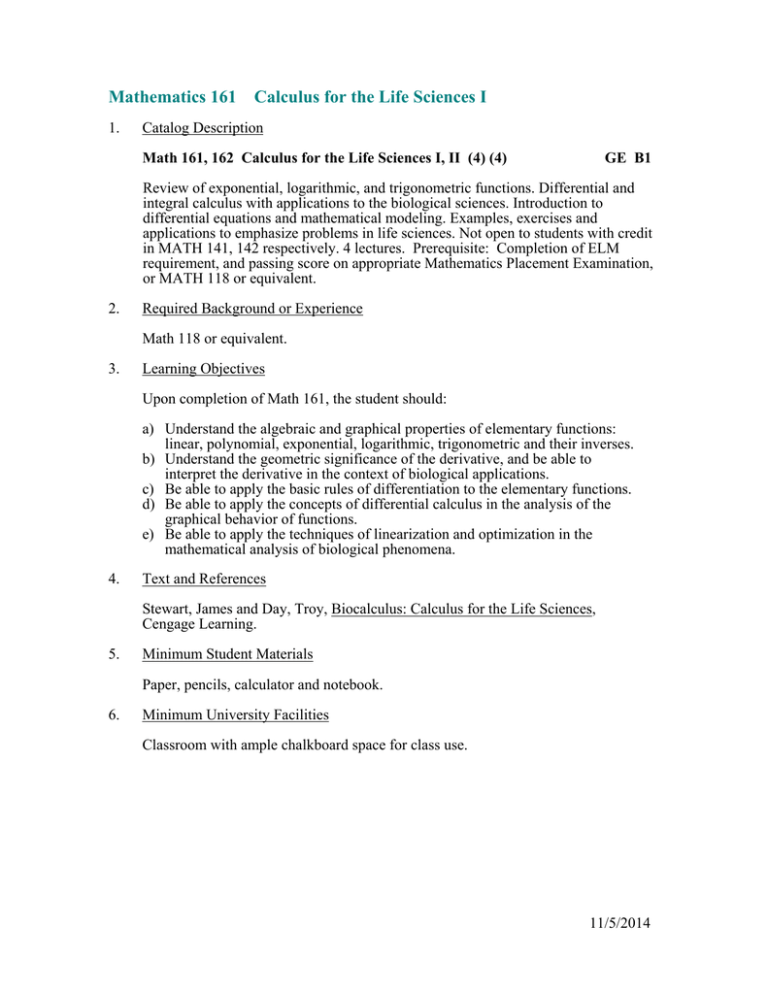
Mathematics 161 Calculus for the Life Sciences I 1. Catalog Description Math 161, 162 Calculus for the Life Sciences I, II (4) (4) GE B1 Review of exponential, logarithmic, and trigonometric functions. Differential and integral calculus with applications to the biological sciences. Introduction to differential equations and mathematical modeling. Examples, exercises and applications to emphasize problems in life sciences. Not open to students with credit in MATH 141, 142 respectively. 4 lectures. Prerequisite: Completion of ELM requirement, and passing score on appropriate Mathematics Placement Examination, or MATH 118 or equivalent. 2. Required Background or Experience Math 118 or equivalent. 3. Learning Objectives Upon completion of Math 161, the student should: a) Understand the algebraic and graphical properties of elementary functions: linear, polynomial, exponential, logarithmic, trigonometric and their inverses. b) Understand the geometric significance of the derivative, and be able to interpret the derivative in the context of biological applications. c) Be able to apply the basic rules of differentiation to the elementary functions. d) Be able to apply the concepts of differential calculus in the analysis of the graphical behavior of functions. e) Be able to apply the techniques of linearization and optimization in the mathematical analysis of biological phenomena. 4. Text and References Stewart, James and Day, Troy, Biocalculus: Calculus for the Life Sciences, Cengage Learning. 5. Minimum Student Materials Paper, pencils, calculator and notebook. 6. Minimum University Facilities Classroom with ample chalkboard space for class use. 11/5/2014 Math 161, page 2. 7. Content and Method Content No. of Lectures 1. Functions and Sequences 1.1 Four Ways to Represent a Function 1.2 A Catalog of Essential Functions 1.3 New Functions from Old Functions 1.4 Exponential Functions 1.5 Logarithms; Semilog and Log-Log Plots 1.6 Sequences and Difference Equations 5 2. Limits 2.1 Limits of Sequences 2.2 Limits of Functions at Infinity 2.3 Limits of Functions at Finite Numbers 2.4 Limits: Algebraic Methods 2.5 Continuity 5 3. Derivatives 3.1 Derivatives and Rates of Change 3.2 The Derivative as a Function 3.3 Basic Differentiation Formulas 3.4 The Product and Quotient Rules 3.5 The Chain Rule 3.6 Exponential Growth and Decay 3.7 Derivatives of the Logarithmic and Inverse Tangent Functions 3.8 Linear Approximations and Taylor Polynomials 11 4. Applications of Derivatives 4.1 Maximum and Minimum Values 4.2 How Derivatives Affect the Shape of a Graph 4.3 L’Hospital’s Rule: Comparing Rates of Growth 4.4 Optimization Problems 4.5 Recursions: Equilibria and Stability 9 _____ Total 30 11/5/2014 Math 161, page 3. Remarks a. When at all possible, use applications from the life sciences to illustrate concepts from calculus. b. Math 119 (Precalculus Trigonometry) is not a prerequisite for this course. Method Largely lecture with blackboard illustration of the discussion along with supervised work and individual conferences. Most examples, exercises and applications will be taken from the life sciences. 8. Methods of Assessment The primary methods of assessment are, in decreasing order of importance: essay examinations, quizzes and homework. Typically, there will be two or three hour-long examinations during the quarter, and a comprehensive final examination. Students are required to show their work, and are graded not only on the correctness of their answers, but also on their understanding of the concepts and techniques. Quizzes are typically given once or twice a week to provide a spot check of student learning. Homework is required daily. 11/5/2014

